Dundradal
Frog Blast the Vent Core!
This update was so long the Chatzone got mad trying to create the thread! So please excuse the abridged portion...
WC vs History - Star Raiders

On the 70th anniversary of the Doolittle Raid, we present the next installment in our WC vs. History series: Star Raiders.
The setbacks of early 1942 left the United States reeling. The Pacific Fleet had been attacked and knocked out at Pearl Harbor the previous December. Wake Island, Guam, and the Philippines had all been attacked and captured by Imperial Japanese forces. The people of the United States needed good news and they needed it yesterday.
The Confederation was in a similar situation following the heavy losses of 2666. Eight carriers had been destroyed that year, halving the entire Confederation carrier force. Others were heavily damaged and needed months of repair and refit. Whereas the Americans needed a moral boost, the Confederation needed a real victory to swing the pendulum of war back towards the humans’ side. Both the Americans and Confederation take extraordinarily bold moves to do just that. They launched “End Runs” at the heart of their respective enemies.
Special Aviation Project No. 1 was the result of a request by President Roosevelt, several weeks after Pearl Harbor, to attack the Japanese Home Islands to boost public morale. The idea for an attack came from the Assistant Chief of Staff of Anti-Submarine Warfare, Captain Francis Low. He thought that twin engine Army bombers could launch from an aircraft carrier after watching bombers land at a nearby Naval Air Station where a carrier outline was painted onto the runway. He brought the idea to Admiral Ernest King in early January 1942. The idea was seen as being worth exploring and an Army bombing unit, under the command of the famed aviator Lt. Colonel Jimmy Doolittle, set out to solve the problem of taking off in less than 500 feet.
The 17th Bomb Group was chosen to carry out the raid because it was the first to receive the B-25 “Mitchell” Medium Bomber in September 1941. By Spring 1942, the 17th was the most experienced B-25 unit. The B-25s required extensive modifications before training could begin. The lower gun turret and the guns were removed from the aircraft, removal of the top-secret Norden bombsight and the installation of additional fuel tanks. The aircraft were then flown to the Pensacola Naval Air Station to begin carrier take off training. After several weeks of training, sixteen crews were chosen to fly to California where they were to meet the new carrier, USS Hornet (CV-8). Sixteen B-25s were loaded onto the Hornet’s flight deck, while the carrier’s own air group was stored below in the ship’s hangar. The carrier and her task force left California on 2 April 1942.
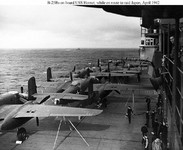
 Two images of the B-25B "Mitchell" medium bombers on the deck of the USS Hornet during the transit across the Pacific. Note the SBD Dauntlesses in the rear facing image parked in between the bombers.
Two images of the B-25B "Mitchell" medium bombers on the deck of the USS Hornet during the transit across the Pacific. Note the SBD Dauntlesses in the rear facing image parked in between the bombers.
Onboard the Hornet, the Army pilots were at first treated with mixed disregard and disdain by the crew. The Army aircraft were keeping the Hornet’s own planes in a position unable to defend the carrier from attack. On 13 April, the Hornet rendezvoused with USS Enterprise and her task force under the command of Vice Admiral William “Bull” Halsey. Scuttlebutt immediately went to work on the ships. What was the Enterprise and Halsey doing here? What was the Hornet doing here with Army bombers on her deck? Later in the day Admiral Halsey made things perfectly clear to the entire force, including the Raiders themselves: “This force is bound for Tokyo!” Admiral Halsey later reported that he never heard a cheer so loud in his entire life before or since as he did at that moment. Treatment of the Army fliers on the Hornet immediately changed. They went from sleeping in the hallways of the carrier to sleeping in bunks as the sailors gave up their racks. The Raiders experienced the best treatment of any Army member on a naval vessel. One can doubt if even MacArthur received the same level when he served afloat.
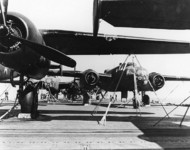
 Looking at the B-25Bs at flight deck level and an image from the fantail of the Hornet.
Looking at the B-25Bs at flight deck level and an image from the fantail of the Hornet.
Colonel Doolittle had been given Japanese “Friendship Medals” that the Japanese government had given to the United States. They were to be returned attached to the fins of American bombs. Captain, future Admiral, Marc Mitscher helped Doolittle attach the medals before the planes were to launch.
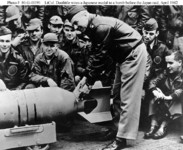
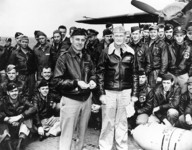 Lt. Colonel Doolittle attaching Japanese friendship medals to a bomb and posing with Captain, future Admiral, Marc Mitscher.
Lt. Colonel Doolittle attaching Japanese friendship medals to a bomb and posing with Captain, future Admiral, Marc Mitscher.
As the combined task force steamed the thousands of miles across the Pacific, they almost made it to the 500 mile launching point without being seen. The plan had been to launch at 500 miles so as to allow the Raiders to bomb Japan during the evening and then fly the 600 miles to China to land with the sun at their backs. However, early on the morning of 18 April, when the Americans were still 650 miles away from Japan, their radar detected a nearby contact. A Japanese picket ship lay just over the horizon. Admiral Halsey ordered his cruisers to open fire and destroy the picket. Halsey also ordered Doolittle and his planes into the air. Knowing the additional distance posed a significant risk, the B-25s were loaded with as many jerry cans of gas as they thought they could safely carry. Before takeoff, Admiral Halsey messaged:
 The Nitto Maru sinks after taking shells from US ships.
The Nitto Maru sinks after taking shells from US ships.
Between 0820 and 0919, sixteen United States Army B-25 “Mitchell” medium bombers launched from the US Navy aircraft carrier, USS Hornet. This is the only time the second time in history, as well as the last, that Army aircraft launched from an aircraft carrier. The first time had in February 1942, off the USS Hornet as well, when Captain Donald Duncan became the first to fly a B-25 from a carrier in 500 feet. Colonel Jimmy Doolittle became the second at 0820. He timed his released with the heaving of the flight deck, as the weather was very rough at the time. He throttled the engines to full, held the brakes and the right moment released them to roar down the flight deck. The B-25 reached the end of the deck at the exact moment it pitched to its maximum height. The aircraft seemed to hang in the air for a moment before dipping from view. It then reemerged flying away from the carrier. The other fifteen B-25s followed. All of the aircraft took off from roughly the same position because of the limited clearance offered the larger wingspan of the bombers of the carrier deck. The wings of the B-25s passed dangerously close to the island of the Hornet and any misjudgement by the pilot would have resulted in a collision and loss of the aircraft.
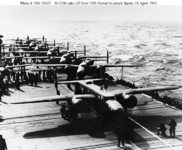
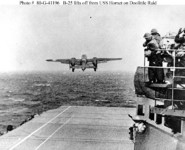
 Lt. Colonel Doolittle launching from the USS Hornet, 18 April 1942.
Lt. Colonel Doolittle launching from the USS Hornet, 18 April 1942.
Because of the launch distance, the sixteen B-25s did not wait to form up before proceeding on to Japan. Instead, each aircraft made their ways independently to the Home Islands flying at tree top level. As happened throughout the Spring of 1942, Lady Luck smiled upon the Americans. The Japanese were running an air raid drill as the Raiders made landfall. Their presence did not cause a stir at first, however once bombs began to fall on Japanese cities that garnered a response from anti-aircraft batteries and fighters. The Raiders were given specific orders not to bomb the Imperial Palace. Those orders were followed, however at a recent conference I heard one of the surviving Raiders describe how they buzzed the Imperial Palace yelling out the window so low “there’s no way he couldn’t have heard us if he was home.”
The Raiders struck a number of Japanese cities including Tokyo, Yokohama, Yokosuka, Nagoya, Kobe and Osaka. The physical damage was minimal, the Japanese dubbing the raid in propaganda the “Doo-Little raid!” The morale damage was enormous. Admiral Yamamoto, as Commander-in-Chief, Combined Fleet, was in charge of protecting the Home Islands from enemy assault. Following the raid, which had so closely threatened the security of the Emperor, Yamamoto locked himself in his cabin for days without food or water his shame was so great. This is where the Doolittle Raid played a role in the Battle of Midway. Yamamoto had been proposing a plan to force the remaining US carriers to battle, but the High Command had refused to give it the go ahead. After the Raid, Yamamoto not only received the green light, he then created the Midway battle plan. A plan that belongs only in textbooks under the heading “What Never To Do With Your Fleet In War.”
Of the 16 planes, one landed outside Vladivostock in the Soviet Union, while the others headed towards China. Eight men from two crews had been captured by the Japanese. The two other members of the crew drowned when trying to escape their bomber off the coast of China. Two of the remaining captured men were later executed by the Japanese. Six other went into detention for the duration. The remaining Raiders variously made their way to extraction points in China. The Japanese killed an estimated quarter million Chinese in their search for the Doolittle Raiders.
The Doolittle Raid was the much needed morale boost President Roosevelt had sought. Doolittle assumed the worst and braced himself for a court martial. He had lost all 16 aircraft after all and caused minimal damage. Instead when he arrived back in the United States, he was awarded the Medal of Honor and was promoted directly to Brigadier General. Every Raider received the Distinguished Flying Cross, along with two Silver Stars for aiding fellow crew members.
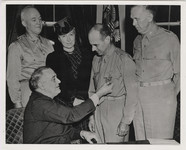
 Recently promoted Brigadier General Doolittle receiving the Medal of Honor from President Roosevelt and all of General Doolittle's military awards.
Recently promoted Brigadier General Doolittle receiving the Medal of Honor from President Roosevelt and all of General Doolittle's military awards.
Last December, I was able to attend the International Conference on World War II at the National World War II Museum of the United States in New Orleans. Five of the six remaining Doolittle Raiders came and gave a great presentation about the Raid and the rest of their times throughout the war. I managed to get autographs on a book about the Raid and a poster of one of the Raider B-25s that I still need to get framed.
...
WC vs History - Star Raiders

For Lt. General "Jimmie" Doolittle, who did the end run first. Thank you, Godspeed, and safe journey. – William Forstchen, Dedication Page, Wing Commander: End Run
An end run is defined as an evasive trick or maneuver. The Doolittle Raid and Raid on Kilrah were both end runs, albeit in different ways. The Doolittle Raid was never meant to inflict serious damage to the Japanese. It was a purely morale operation and it succeeded expectations. What made it an end run was the use of twin engine Army Air Corps B-25 medium bombers from an aircraft carrier. The Raid on Kilrah was expected only to divert a part of the Kilrathi Home Fleet, if the raid inflicted some damage on military targets it was a bonus. It was the end run. By attacking the Kilrah system itself in order to split the Kilrathi fleet rushing to seek revenge was a masterful deceit. That Strike Force Valkyrie not only caused the splitting of the Kilrathi fleet, but also massive damage to the ship construction installations on Largkza was a victory comparable to the one it enabled at Vukar Tag.On the 70th anniversary of the Doolittle Raid, we present the next installment in our WC vs. History series: Star Raiders.
The setbacks of early 1942 left the United States reeling. The Pacific Fleet had been attacked and knocked out at Pearl Harbor the previous December. Wake Island, Guam, and the Philippines had all been attacked and captured by Imperial Japanese forces. The people of the United States needed good news and they needed it yesterday.
The Confederation was in a similar situation following the heavy losses of 2666. Eight carriers had been destroyed that year, halving the entire Confederation carrier force. Others were heavily damaged and needed months of repair and refit. Whereas the Americans needed a moral boost, the Confederation needed a real victory to swing the pendulum of war back towards the humans’ side. Both the Americans and Confederation take extraordinarily bold moves to do just that. They launched “End Runs” at the heart of their respective enemies.
Special Aviation Project No. 1 was the result of a request by President Roosevelt, several weeks after Pearl Harbor, to attack the Japanese Home Islands to boost public morale. The idea for an attack came from the Assistant Chief of Staff of Anti-Submarine Warfare, Captain Francis Low. He thought that twin engine Army bombers could launch from an aircraft carrier after watching bombers land at a nearby Naval Air Station where a carrier outline was painted onto the runway. He brought the idea to Admiral Ernest King in early January 1942. The idea was seen as being worth exploring and an Army bombing unit, under the command of the famed aviator Lt. Colonel Jimmy Doolittle, set out to solve the problem of taking off in less than 500 feet.
The 17th Bomb Group was chosen to carry out the raid because it was the first to receive the B-25 “Mitchell” Medium Bomber in September 1941. By Spring 1942, the 17th was the most experienced B-25 unit. The B-25s required extensive modifications before training could begin. The lower gun turret and the guns were removed from the aircraft, removal of the top-secret Norden bombsight and the installation of additional fuel tanks. The aircraft were then flown to the Pensacola Naval Air Station to begin carrier take off training. After several weeks of training, sixteen crews were chosen to fly to California where they were to meet the new carrier, USS Hornet (CV-8). Sixteen B-25s were loaded onto the Hornet’s flight deck, while the carrier’s own air group was stored below in the ship’s hangar. The carrier and her task force left California on 2 April 1942.

 Two images of the B-25B "Mitchell" medium bombers on the deck of the USS Hornet during the transit across the Pacific. Note the SBD Dauntlesses in the rear facing image parked in between the bombers.
Two images of the B-25B "Mitchell" medium bombers on the deck of the USS Hornet during the transit across the Pacific. Note the SBD Dauntlesses in the rear facing image parked in between the bombers.Onboard the Hornet, the Army pilots were at first treated with mixed disregard and disdain by the crew. The Army aircraft were keeping the Hornet’s own planes in a position unable to defend the carrier from attack. On 13 April, the Hornet rendezvoused with USS Enterprise and her task force under the command of Vice Admiral William “Bull” Halsey. Scuttlebutt immediately went to work on the ships. What was the Enterprise and Halsey doing here? What was the Hornet doing here with Army bombers on her deck? Later in the day Admiral Halsey made things perfectly clear to the entire force, including the Raiders themselves: “This force is bound for Tokyo!” Admiral Halsey later reported that he never heard a cheer so loud in his entire life before or since as he did at that moment. Treatment of the Army fliers on the Hornet immediately changed. They went from sleeping in the hallways of the carrier to sleeping in bunks as the sailors gave up their racks. The Raiders experienced the best treatment of any Army member on a naval vessel. One can doubt if even MacArthur received the same level when he served afloat.

 Looking at the B-25Bs at flight deck level and an image from the fantail of the Hornet.
Looking at the B-25Bs at flight deck level and an image from the fantail of the Hornet.Colonel Doolittle had been given Japanese “Friendship Medals” that the Japanese government had given to the United States. They were to be returned attached to the fins of American bombs. Captain, future Admiral, Marc Mitscher helped Doolittle attach the medals before the planes were to launch.

 Lt. Colonel Doolittle attaching Japanese friendship medals to a bomb and posing with Captain, future Admiral, Marc Mitscher.
Lt. Colonel Doolittle attaching Japanese friendship medals to a bomb and posing with Captain, future Admiral, Marc Mitscher.As the combined task force steamed the thousands of miles across the Pacific, they almost made it to the 500 mile launching point without being seen. The plan had been to launch at 500 miles so as to allow the Raiders to bomb Japan during the evening and then fly the 600 miles to China to land with the sun at their backs. However, early on the morning of 18 April, when the Americans were still 650 miles away from Japan, their radar detected a nearby contact. A Japanese picket ship lay just over the horizon. Admiral Halsey ordered his cruisers to open fire and destroy the picket. Halsey also ordered Doolittle and his planes into the air. Knowing the additional distance posed a significant risk, the B-25s were loaded with as many jerry cans of gas as they thought they could safely carry. Before takeoff, Admiral Halsey messaged:
TO COL. DOOLITTLE AND HIS GALLANT COMMAND
GOOD LUCK AND GOD BLESS YOU – HALSEY
GOOD LUCK AND GOD BLESS YOU – HALSEY
 The Nitto Maru sinks after taking shells from US ships.
The Nitto Maru sinks after taking shells from US ships.Between 0820 and 0919, sixteen United States Army B-25 “Mitchell” medium bombers launched from the US Navy aircraft carrier, USS Hornet. This is the only time the second time in history, as well as the last, that Army aircraft launched from an aircraft carrier. The first time had in February 1942, off the USS Hornet as well, when Captain Donald Duncan became the first to fly a B-25 from a carrier in 500 feet. Colonel Jimmy Doolittle became the second at 0820. He timed his released with the heaving of the flight deck, as the weather was very rough at the time. He throttled the engines to full, held the brakes and the right moment released them to roar down the flight deck. The B-25 reached the end of the deck at the exact moment it pitched to its maximum height. The aircraft seemed to hang in the air for a moment before dipping from view. It then reemerged flying away from the carrier. The other fifteen B-25s followed. All of the aircraft took off from roughly the same position because of the limited clearance offered the larger wingspan of the bombers of the carrier deck. The wings of the B-25s passed dangerously close to the island of the Hornet and any misjudgement by the pilot would have resulted in a collision and loss of the aircraft.


 Lt. Colonel Doolittle launching from the USS Hornet, 18 April 1942.
Lt. Colonel Doolittle launching from the USS Hornet, 18 April 1942.Because of the launch distance, the sixteen B-25s did not wait to form up before proceeding on to Japan. Instead, each aircraft made their ways independently to the Home Islands flying at tree top level. As happened throughout the Spring of 1942, Lady Luck smiled upon the Americans. The Japanese were running an air raid drill as the Raiders made landfall. Their presence did not cause a stir at first, however once bombs began to fall on Japanese cities that garnered a response from anti-aircraft batteries and fighters. The Raiders were given specific orders not to bomb the Imperial Palace. Those orders were followed, however at a recent conference I heard one of the surviving Raiders describe how they buzzed the Imperial Palace yelling out the window so low “there’s no way he couldn’t have heard us if he was home.”
The Raiders struck a number of Japanese cities including Tokyo, Yokohama, Yokosuka, Nagoya, Kobe and Osaka. The physical damage was minimal, the Japanese dubbing the raid in propaganda the “Doo-Little raid!” The morale damage was enormous. Admiral Yamamoto, as Commander-in-Chief, Combined Fleet, was in charge of protecting the Home Islands from enemy assault. Following the raid, which had so closely threatened the security of the Emperor, Yamamoto locked himself in his cabin for days without food or water his shame was so great. This is where the Doolittle Raid played a role in the Battle of Midway. Yamamoto had been proposing a plan to force the remaining US carriers to battle, but the High Command had refused to give it the go ahead. After the Raid, Yamamoto not only received the green light, he then created the Midway battle plan. A plan that belongs only in textbooks under the heading “What Never To Do With Your Fleet In War.”
Of the 16 planes, one landed outside Vladivostock in the Soviet Union, while the others headed towards China. Eight men from two crews had been captured by the Japanese. The two other members of the crew drowned when trying to escape their bomber off the coast of China. Two of the remaining captured men were later executed by the Japanese. Six other went into detention for the duration. The remaining Raiders variously made their way to extraction points in China. The Japanese killed an estimated quarter million Chinese in their search for the Doolittle Raiders.
The Doolittle Raid was the much needed morale boost President Roosevelt had sought. Doolittle assumed the worst and braced himself for a court martial. He had lost all 16 aircraft after all and caused minimal damage. Instead when he arrived back in the United States, he was awarded the Medal of Honor and was promoted directly to Brigadier General. Every Raider received the Distinguished Flying Cross, along with two Silver Stars for aiding fellow crew members.

 Recently promoted Brigadier General Doolittle receiving the Medal of Honor from President Roosevelt and all of General Doolittle's military awards.
Recently promoted Brigadier General Doolittle receiving the Medal of Honor from President Roosevelt and all of General Doolittle's military awards.Last December, I was able to attend the International Conference on World War II at the National World War II Museum of the United States in New Orleans. Five of the six remaining Doolittle Raiders came and gave a great presentation about the Raid and the rest of their times throughout the war. I managed to get autographs on a book about the Raid and a poster of one of the Raider B-25s that I still need to get framed.
...
Last edited by a moderator:
